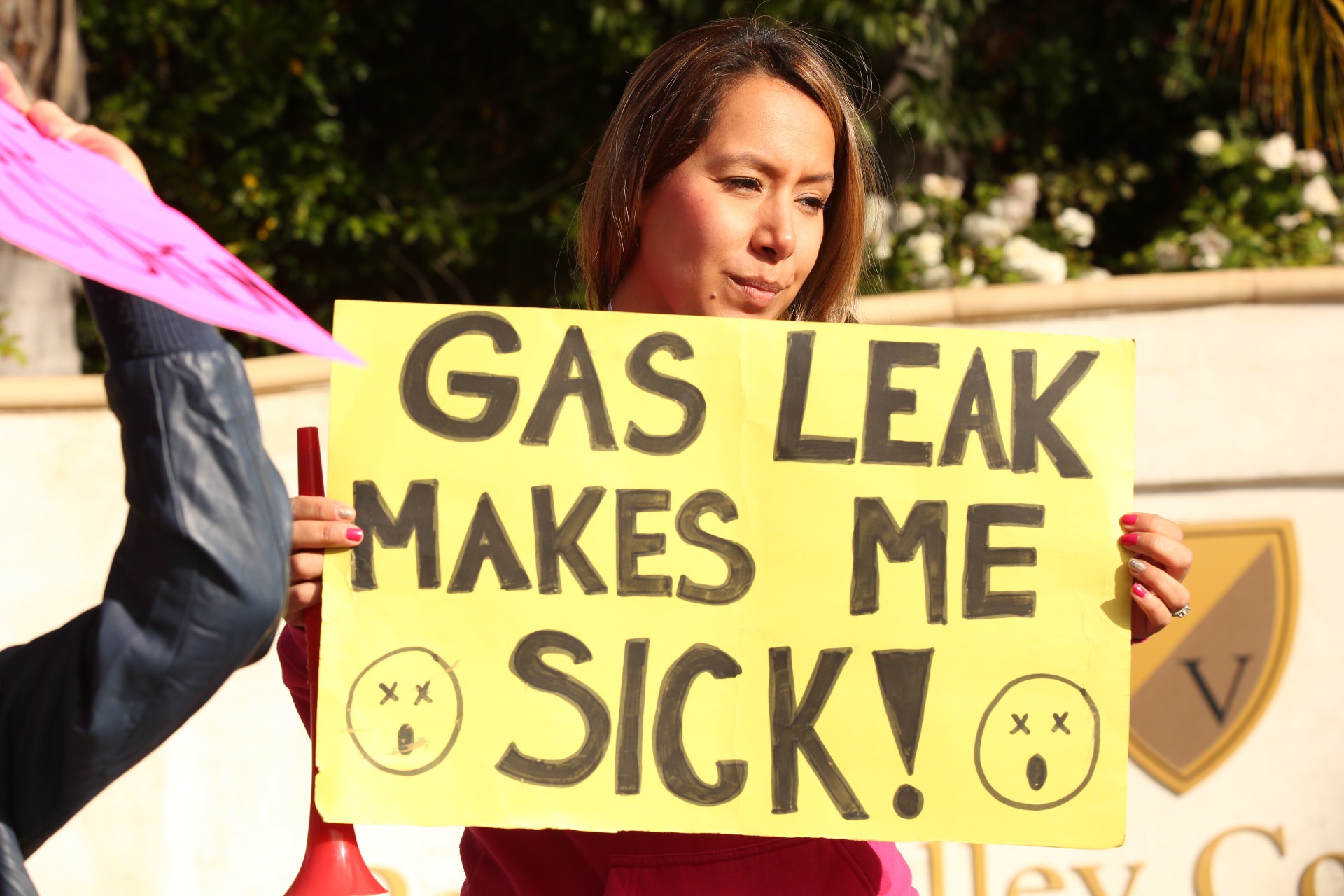
A massive natural gas leak in California is still releasing huge amounts of methane into the environment almost two months after it began, driving over a thousand families from their homes and prompting the FAA to create a no-fly zone over the area.
The Aliso Canyon gas storage facility near the Porter Ranch neighborhood of Los Angeles started leaking massive amounts of methane into the San Fernando Valley area on Oct. 23. The leak occurred in a pipe casing hundreds of feet below the ground, in a storage facility owned by the Southern California Gas Co. that reaches over 8,500 feet below the surface. The gas is leaking into the earth and seeping up through the ground, according to the Los Angeles Times.
Methane is odorless, but natural gas has a sulfurous smell. And while health officials say that long-term health effects are unlikely, the smell alone has caused more than 1,600 nearby families to flee already, and more than 1,700 others have applied for assistance to vacate the area as of Dec. 14 (officials have ordered the company to help relocate residents.) On Dec. 9, the FAA announced a no-fly zone for low-flying aircrafts over the area until March, presumably so that engine sparks don’t combust in the highly flammable methane.
At least one Porter Ranch family has sued the company for health problems relating to the methane leak. Brian and Christine Katz are suing Southern California Gas Co. for negligence and seeking financial compensation after their five children and two dogs allegedly fell sick because of exposure to natural gas.
According to a complaint filed in Los Angeles County Superior Court discovered by the L.A. Times, their previously healthy two-year old daughter suffered a seizure, nausea, respiratory problems, and spent four nights in the ICU from the gas exposure. Los Angeles City Attorney Mike Feuer is also suing the company.
In a statement, SoCalGas apologized for the disruption caused by the leak. “We are deeply sorry for the impact on the community and the environment. We have assembled a world-class team of experts and we are working as quickly and as safely as possible to stop the leak and reduce the amount of natural gas emitting into the atmosphere.”
Earthworks, an environmental nonprofit which focuses on protecting communities from research extraction, has taken a video of the methane leak using a ITC-certified thermographer to see the usually invisible natural gas. “Communities who complain about oil and gas development’s air pollution are often dismissed by industry and regulators because what you can’t see is easy to ignore,” says Alan Septoff, an Earthworks spokesman. “By making visible normally invisible pollution, we help communities get the attention they need to better protect their health.” Here’s a video they took of the Aliso Canyon leak:
The leak could also have major environmental consequences, according to a Nov. 20 report by the California Air Resources Board. Natural gas is 80% methane, which is has more than 70x the global warming impact of carbon dioxide over a 20 year period. The leak has already increased statewide methane emissions by about 25%, in a state that has pledged to reduce methane emissions by 40% by 2030.
According to the most recent report from the California Air Resources Board, the leak is still emitting about 36,000 kilograms of methane per hour (down from 58,000 at the end of November) and has emitted a total of almost 59 million kilograms since the leak began. SoCalGas hasn’t put a figure on what all this will cost, but warned in a statement that “any estimates published in the news media or elsewhere on the potential costs of this incident are premature and purely speculative.”
And yet almost two months on, there’s no end in sight. Last week, state regulators ordered the company to deliver an updated plan for fixing the leak and capture as much gas as possible. But that won’t be easy. First of all, drillers must find the leaking pipe (only seven inches in diameter) thousands of feet below the ground. And since methane is so flammable, the leak makes work slow going, as workers can’t use any tools (like lights) that could create excess sparks, which means that the crew can only work at the leaking site during daylight hours, according to WIRED. Another possible reason for the delay is the difficult geology of the area. The team has to stop, clean and cool their equipment after drilling through just 20 or 30 feet of difficult terrain, explains Dave Clegern of the California Air Resources Board.
After repeatedly attempting to stop the gas leak by pouring liquid into the ground without success, SoCalGas announced on Dec. 7 that they have started drilling a relief well to intercept the Aliso Canyon pipe and plug the leak, a process which could take three to four months. How much more methane will be emitted by then is anyone’s guess.
More Must-Reads from TIME
- Donald Trump Is TIME's 2024 Person of the Year
- Why We Chose Trump as Person of the Year
- Is Intermittent Fasting Good or Bad for You?
- The 100 Must-Read Books of 2024
- The 20 Best Christmas TV Episodes
- Column: If Optimism Feels Ridiculous Now, Try Hope
- The Future of Climate Action Is Trade Policy
- Merle Bombardieri Is Helping People Make the Baby Decision
Write to Charlotte Alter at charlotte.alter@time.com